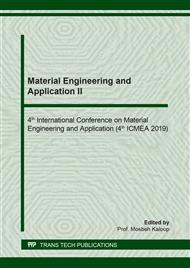p.182
p.188
p.193
p.198
p.203
p.209
p.214
p.220
p.225
Characterization of Hydraulic Concrete with Polystyrene-Based Emulsion
Abstract:
The following investigation was carried out with the objective of characterizing a concrete added with an emulsion based on reused polystyrene. The tests that were carried out for this characterization are: compression resistance, resistivity and ultrasonic pulse speed, in addition to the proper characterization of the stone material. A control mixture was also made and one in which a fluidiser is added in order to compare the results of these mixtures against the results of the concrete added with emulsion. The proportions of the emulsion are 1% and 4% because in the setting times [1], made in previous research results in that 1% is the beginning of setting and 4% the end of it. Values greater than 4% exceed the time allowed in the NMX-C-177-1997 ONNCCE standard.
Info:
Periodical:
Pages:
203-208
Citation:
Online since:
May 2020
Keywords:
Price:
Сopyright:
© 2020 Trans Tech Publications Ltd. All Rights Reserved
Share:
Citation:


